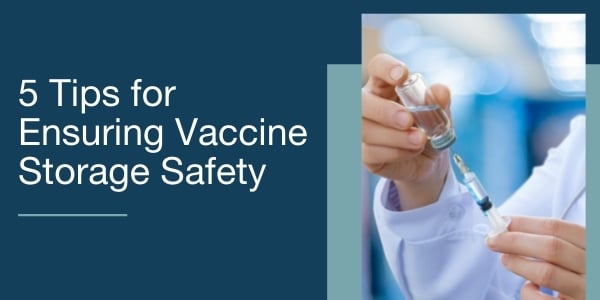
Ensuring vaccines are stored in accordance with manufactures’ recommendations and in compliance with facility, state and local guidelines are important to maintaining a safe vaccine program. Protecting vaccines from improper storage can help prevent ineffective or destroyed vaccines and help promote patient confidence in vaccines.
While there are a variety of facility and state requirements for vaccine programs, most facilities and other 3rd party audit agencies follow the CDC’s Vaccine Storage and Handling Toolkit guidelines for vaccine storage. Additionally, a new standard for vaccine storage, NSF / ANSI 456, was recently published and outlines performance criteria for vaccine storage units. This new standard will enable vaccine storage manufacturers to test and certify units to meet the NSF / ANSI 456 Vaccine Storage standard, providing additional confidence among vaccine providers and clinicians.
Here are 5 tips for ensuring your facility is storing vaccines safely:
- The CDC recommends the use of purpose-built or medical-grade units, designed to store vaccines and medications. Dorm style or combination units are prohibited. Using a medical-grade storage unit with fan-forced air circulation helps promote temperature uniformity throughout the unit.
- The CDC also recommends utilizing a digital data logger (DDL) with a valid certificate of calibration to monitor the temperature of the unit. These DDLs should include out-of-range alarms, low-battery indicators, and a current, minimum, and maximum temperature display.
- Routine maintenance and testing of vaccine storage units ensures vaccine storage and related equipment functions at maximum efficiency.
- Select a vaccine storage unit that has been tested and certified to meet the new NSF / ANSI 456 Vaccine Storage standard. This new standard is designed to ensure vaccine storage units can maintain temperature uniformity and recovery under various load conditions and door openings.
- In addition to CDC guidelines around DDL certificates of calibration, the new NSF / ANSI 456 Vaccine Storage standard will require certified units have a certificate of calibration for the unit. Having both will help facilities to meet compliance and audit requirements.
OTHER BLOGS YOU MAY BE INTERESTED IN...
- Vaccine Storage Safety and the Importance of Routine Maintenance
- Medical-Grade Vaccine Storage Can Help Prevent Vaccine and Financial Loss
- Meet CDC Guidelines for Vaccine Storage with Helmer’s i.C3® Information Center
To learn more about our line of GX Solutions vaccine storage units and how Helmer can support your vaccine storage needs, download our Vaccine Storage Solutions Guide.




